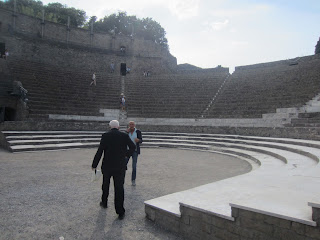Friday we attended the Funeral of Archbishop Giuseppe De Andrea. He was a priest of Greensburg, PA - but had served in the Diplomatic Service for many years - including service as the Apostolic Nuncio in Kuwait, Bahrain, Yemen and Qatar and the Delegate to the Arabian Peninsula from 2001-2005. Thereafter, he returned to Rome and was a Canon at St. Peter's Basilica. While here in Rome he also served for a time as the Assessore at the Order - assisting in the time of transition between Cardinal Foley and, then, Archbishop O'Brien.
Funerals at St. Peter's are reverent but to the point. Archbishop De Andrea died on Wednesday night - his funeral was Friday. It's a simple casket on the floor with a Gospel book placed upon it. The Basilica's choir sings. Mass it at the "Altar of the Chair." Purple vestments to remind us of the penance yet to be done by many of us - even after death.
Eternal rest grant unto him, O Lord. And let perpetual Light shine upon him. May he rest in peace. May his soul and the souls of all the faithful departed, through the mercy of God, rest in peace. Amen.
But that same day, we had the opportunity to say: Happy 4th of July!
We were invited to an official diplomatic celebration of the 4th at the Embassy of the United States to the Holy See. As you can imagine with all that is happening in the world today - security was tight - but the atmosphere in side was very warm! A Gospel choir singing, Marines in full dress uniform presenting the Colors, the National Anthem, speeches and, of course, FOOD: hot dogs, hamburgers - I even found a veggie burger - YUMMY! A great way to celebrate the 4th!








































